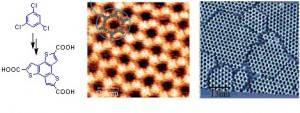You can’t rush out and buy products with organic nanoelectronic components yet but one day you will and you’ll have Dr. Dmitrii Perepichka at McGill University (Montréal, Canada), Dr. Federico Rosei of the Institut national de la recherche scientifique and the members of their international research team to thank for it. From the McGill University news release,
Although they could revolutionize a wide range of high-tech products such as computer displays or solar cells, organic materials do not have the same ordered chemical composition as inorganic materials, preventing scientists from using them to their full potential. But an international team of researchers led by McGill’s Dr. Dmitrii Perepichka and the Institut national de la recherche scientifique’s Dr. Federico Rosei have published research that shows how to solve this decades-old conundrum. The team has effectively discovered a way to order the molecules in the PEDOT, the single most industrially important conducting polymer.
This is an important step forward for anyone who owns a computer or a mobile phone or anything with transistors. In the 1960s a fellow called Gordon Moore (he went on to co-found Intel) made a prediction (from Intel’s Moore’s Law web page),
Intel co-founder Gordon Moore is a visionary. In 1965, his prediction, popularly known as Moore’s Law, states that the number of transistors on a chip will double about every two years. And Intel has kept that pace for nearly 40 years.
We are almost at the physical limits given our current technologies which is why this new type of organic component is important. Perepichka while noting that there’s still a considerable amount of work to be done before being able to create organic nanoelectronic components speculates about future uses,
By using molecular materials instead of silicon semiconductor, we could one day build transistors that are ten times smaller than what currently exists.” The chips would in fact be only one molecule thick.
The groundbreaking technique used to achieve this capability,
… sounds deceptively simple. The team used an inorganic material – a crystal of copper – as a template. When molecules are dropped onto the crystal, the crystal provokes a chemical reaction and creates a conducting polymer. By using a scanning probe microscope that enabled them to see surfaces with atomic resolution, the researchers discovered that the polymers had imitated the order of the crystal surface. The team is currently only able to produce the reaction in one dimension, i.e. to make a string or line of molecules. The next step will be to add a second dimension in order to make continuous sheets (“organic graphite”) or electronic circuits.
Here are images of the polymer with its chemical composition (at the left),

This image shows the polymers that were created at a resolution of 5 nanometres (the average strand of human hair is 80,000 nanometres wide) Source: Dept. of Chemistry, McGill University
I was interested to note that part of the funding for this project comes from the US Air Force since they also recently funded work on integrating memristors in electronic components (my blog posting here). Here’s my last excerpt from the news release details about the researchers’ affiliations, where the study was published, and the funding sources for the work,
Perepichka is affiliated with McGill University’s department of chemistry and Rosei is affiliated with Institut national de la recherche scientifique – Énergie Matériaux Télécommunications Center, a member of the Université du Québec network. Their research was published online by the Proceedings of the National Academy of Sciences and was funded by the Natural Sciences and Engineering Research Council of Canada, the Air Force Office of Scientific Research and Asian Office of Aerospace Research and Development of the USA, the Petroleum Research Fund of the American Chemical Society, the Fonds québécois de recherche sur la nature et les technologies, and the Ministère du Développement économique, de l’Innovation et de l’Exportation of Quebec.
